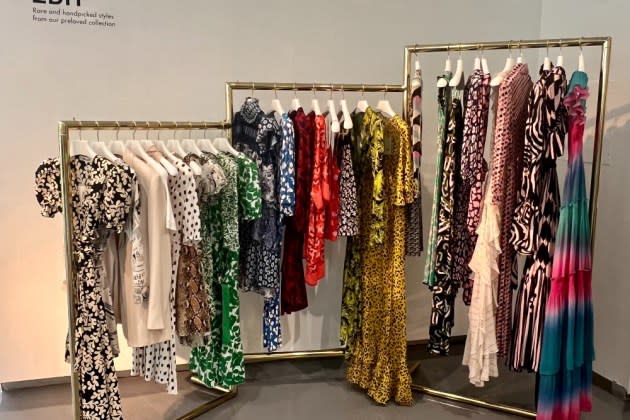Archive CEO Says Stores are Branded Resale’s Next Frontier

The future of branded resale is omnichannel.
That’s according to Emily Gittins, founder and CEO of re-commerce technology platform Archive. While the four-year-old firm has built a business helping brands like M.M.LaFleur, Marrimekko and The North Face build out branded online channels for secondhand sales, it’s evolving to meet consumers where they are.
More from Sourcing Journal
All Treets, No Tricks for This Resale Marketplace's Earth Day Shoppers
What Goes Around Comes Around Claps Back at 'Radical' Chanel Injunction
“We’re seeing a consumer who wants to shop across e-commerce and retail quite fluidly, and wants that consistent brand story across the two,” she told Sourcing Journal. “That’s pushing brands to think about, ‘How can we replicate some of the exciting things we’re doing [on the web] into our stores?’”
“I think it’s a desire to have a really holistic story across digital and retail channels that is leading to this,” Gittins added.
This month, Diane Von Furstenberg launched its second in-store resale curation at its flagship in New York’s Meatpacking district, following up on an event it staged with Archive last fall to celebrate “Secondhand September.”
The heritage women’s wear brand, made famous by its iconic wrap dress (which celebrates its 50th anniversary this year), made its foray into resale last May with a channel called ReWrap. The “ReWrap Edit” brings several racks of pre-owned and vintage pieces to a store setting, where shoppers can see them in the flesh.
According to Gittins, several Archive partners have launched omnichannel initiatives in recent months out of a desire to continue the momentum generated by their on-site branded resale channels.
M.M.LaFleur, for example, this week expanded its Second Act platform with a take-back program, allowing consumers to drop off their pre-owned items in stores or mail them back to the company for a gift card or store credit. It’s also trialing in-store secondhand sales this month at several locations. These options round out the women’s wear label’s three-year-old peer-to-peer online selling platform, giving shoppers several ways to offload unwanted apparel and engage with the brand.
“It’s really about giving that consumer a lot of flexibility and optionality to pick whatever makes sense for them to get that supply,” Gittins said.
Meanwhile, California casual wear brand Faherty launched “Second Wave Take Back Week,” an expansion of the brand’s Second Wave branded resale platform, in stores this week. Shoppers can bring in pre-owned Faherty products and receive a 20-percent discount on their in-store purchase.
Toggling from online to the physical realm is no easy feat, Gittins said. For those looking to experiment with in-store resale, “It’s all about having the right mix of supply,” she explained. “We’ve built software that helps brands decide which pieces to send to which stores to enable the right spread of sizes and categories and the seasonally appropriate items for that location,” she added. “That is a very difficult problem to solve with secondhand, and quite different how brands solve it with new products.”
According to the founder, Archive is evolving its software’s capabilities to “support brands with that puzzle,” as well as facilitate point-of-sale in stores. Selling single SKUs, or even multiples of the same SKU in different conditions, presents its own conundrum at brick-and-mortar stores accustomed to dealing solely with new product. Creative leveraging of technology is helping to solve those issues as well, with some brands using QR codes to provide digital experiences that allow consumers to check out on their own mobile devices, bypassing the cash register.
Despite the speedbumps, Gittins said she believes the omnichannel branded resale experience is likely to accelerate in the months to come.
“I think for a lot of brands, their secondhand program is a really exciting moment to storytell about the quality of their product, and often the heritage of the brand as well,” she said. “There’s something different about having that product in store, where the consumer can actually feel it and viscerally understand that this is a high-quality item that they can feel good about investing in.”
Archive continues to grow its web-based branded resale portfolio as well, having launched programs with brands like New Balance, Dr. Martens and Christy Dawn in recent months. “I think resale in general is just growing so quickly—and brand owned resale as a segment is so early in its trajectory. A few years ago, only a handful of brands had programs, and now 250-plus brands have their own resale channel.”
“All of our programs are profitable and a lot of our brands actually have higher margin on their resale business than on their overall business,” she added. Gittins pointed to ThredUp’s latest Resale Report, wherein 67 percent of brands with resale programs reported believing that those channels would soon account for over 10 percent of their overall revenue.
“Brands are saying, ‘Let’s think about how we expand this and really make it a significant part of our growth story in the next few years,’ which is why we’re seeing them expand to new channels, like stores,” she explained.
“I think that signals the broader shift that we’re seeing here, where resale has gone from… a really exciting new initiative and marketing play—and the right thing to do as a brand for the planet—to a real business that can drive significant revenue,” Gittins added.
